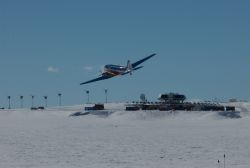A successful season for science and technology at the Princess Elisabeth Antarctic Station!
The summer season has come to an end in Antarctica and the entire team has come home to Europe. The scientists accomplished a lot, and thanks to its impressive energy-saving technologies such as its “smart grid”, the Princess Elisabeth Station functioned well as a “zero emission” station.
Seven research projects were undertaken this year, mainly by Belgian scientists, but also by German and Japanese scientists. We’ve described some of these projects in the previous EducaPoles news items on scientific research at the station (parts 1 and 2). Most of these were carried out in the Sør Rondane Mountains in Queen Maud Land (East Antarctica) – one of the least explored areas of the continent.
The polar researchers were lucky to make important finds.
For example, the German team of the Bundesanstalt für Geowissenschaften und Rohstoffe (BGR)has been trying to get a better understanding of the geological history of the Queen Maud Land. They’ve been searching for the suture zone where two continental land masses collided with each other during the formation of the ancient Godwana supercontinent more than 500 million years ago. They think they’ve found the suture zone, but they still need to do laboratory tests on rock samples they took in Antarctica to be sure. To learn about the other scientific discoveries this season, check out the news of March 14, 2011 on www.antarcicstation.org.
Besides the scientific discoveries, the research teams also successfully installed several instruments. For example, the BELATMOS team set up instruments to monitor how the chemical composition and the amount of tiny particles in the Antarctic atmosphere changes over time as well as the amount of UV radiation reaching the Earth’s surface in Antarctica.
Another accomplishment this past season is that the Princess Elisabeth Station ran as a zero emission station – using only renewable energies – for most of the season. This is possible thanks to energy-saving technologies such as a smart grid to manage how energy is produced and used in the station.
What is a smart grid? Well, in most industrialized countries of the world, power is produced to match the consumption needs of the people using it. The station’s smart grid does the exact opposite: with only wind and solar power to produce energy, people’s energy consumption must to be adapted to the station’s energy production (which can depend on the weather). This is where the smart grid comes in. It distributes available power throughout the station based on pre-defined priorities based on the time of day (meal time, office time, etc.). If it is stormy outside and the wind turbines can provide enough wind energy to meet the entire energy consumption needs of the base, then the DPMS (Demand Power Management System) will provide power to all parts of the station and may even charge the batteries, which store excess energy the station produces. But on days when not a lot of energy is produced, the system checks the state of the batteries to see if there is enough reserve power, and based on how much energy is available, switches off the circuits to parts of the station that are less essential at that time of day (e.g. garage, washing machines).
Living with this system can cause some frustrations when there is not much energy available and some parts of the station must be switched off. It’s no use complaining, even if you wanted to recharge your mp3 player... For example, the cook can only use the oven between 10:30 am and noon. Despite the minor inconveniences, the station team and researchers got used to this new way of using energy.
The smart grid system is a prototype that was developed specially for the Princess Elisabeth Station. It may well give us an idea of what energy management may be like in a future, where ideally, most of our energy will come from renewable energy sources.
To learn more about the Princess Elisabeth Station, you can take a look at our educational dossiers and the www.antarcticstation.org website, which has more images and videos.









